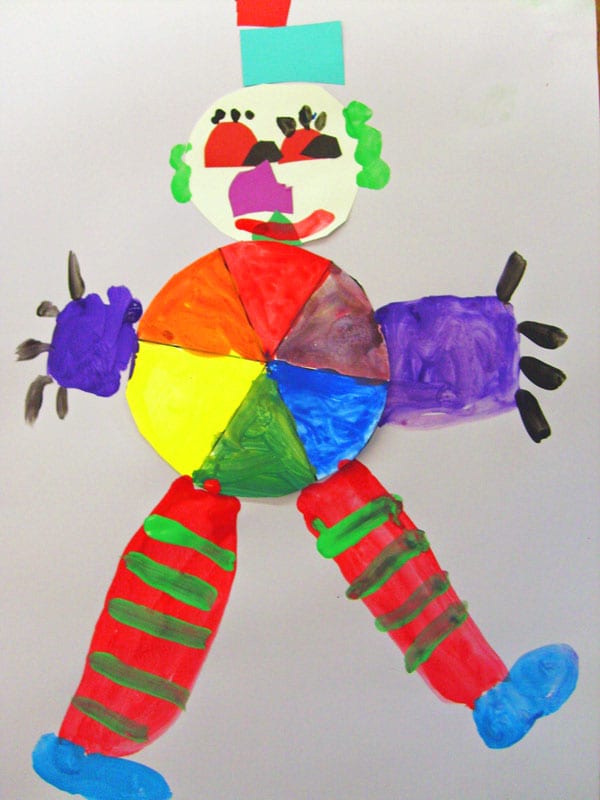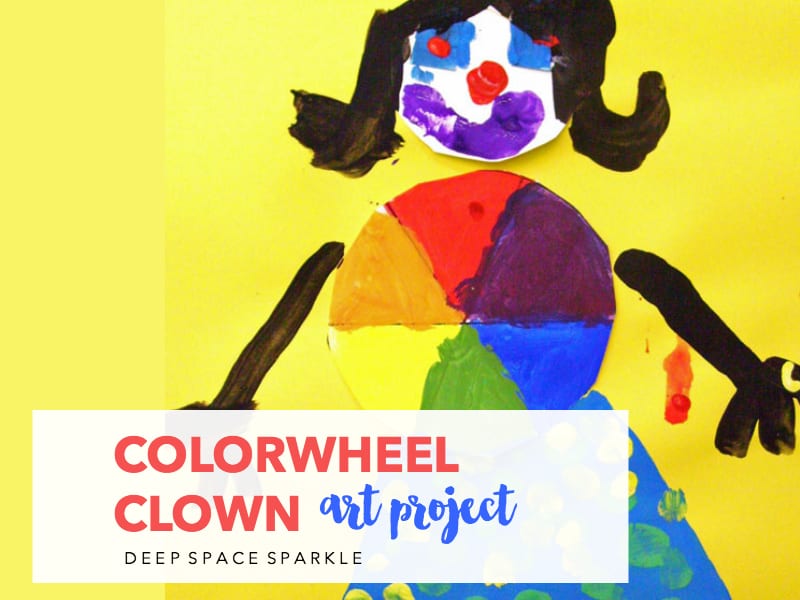I wish I could remember the website where I found this lesson! It’s one of my favorite kinder lessons that incorporates a color wheel. This lesson is a bit involved. It usually takes three 30-minute classes to complete this project but it’s worth it.
You’ll need the following:
– White card stock with a color wheel pattern (I made mine by tracing the bottom of a container and adding the lines).
– Plain white card stock (for the head)
– Small pieces of leftover construction paper in a variety of colors.
– 12″ x 18″ colored construction paper for each child.
– Glue sticks
– Red, yellow and blue tempera paint
– Pencil, scissors and a plastic cup for each child

Making the color wheel
Pass out a blank color wheel to each child. Each child should have their own paper plate with a small dab of yellow, red and blue paint, a small paint brush and a container of water to share.
Instruct the children to paint one “pizza” slice yellow, then red, then blue. Next, ask the children to paint a slice with the color orange. They’ll tell you that they don’t have any orange paint so you’ll show them how. Do the same for purple and green. Set the color wheels to the side to dry.
Next, have the children trace the opening of the plastic cup onto the blank piece of paper. This will later be the face. If there is time, cut out the face.
Adding facial features with paper
Now that the color wheel is dry, the children can cut around the edges. Glue the face and color wheel (belly) to the colored sheet of construction paper. Make sure to glue the head first and demonstrate the proper place to glue it.
Once the face and belly are in place, the kids can use the small bits of colored paper to add eyes, a nose, a mouth and even hair to their clown’s face.
Painting the clown’s outfit
Using tempera paints, paint hair, arms, dress, pants, clown shoes, etc. on construction paper. Encourage patterns like polka dots and stripes.
FIND MORE COLORWHEEL LESSONS IN THE MEMBERS CLUB. CLICK BELOW…














Patty,
I came across your blog as I was getting traffic from your site. Wow!!!I love your art lessons. I think I will be borrowing a few. Wonderful work. Thanks for putting me on your blog roll. I have put you on mine.
Hi Gail,
I recently discovered your blog as well. Very inspiring. Thanks for adding me to your blog roll!
Hi Patty! I'm a homeschooling mome of a five and three year old and just came across your blog. Love it! We did the colorwheel clowns today and they had so much fun. I can't wait to do more of your projects! I've been searcing the web for art ideas and thank goodness I found your site! Lots of cool stuff to do.
Thanks Regina! I think these clowns are adorable too. Enjoy your time with your little ones…it goes by quickly,
Hi Patty,
I tried this lesson with my two of my Kinder classes and the results were pretty good up until the last step. Do you have any painting tips to prevent the kids from sabotaging their projects at the very end with paint? Have you experienced anything similar with this project?
I should probably mention that I work mostly with project kids with little to no prior art experience. The few kids that showed success with this project are not from the projects. Probably explains a lot, huh? I still love this project and am tempted to give it another go with the first graders.
Hi Spoosh,
I certainly understand how part three of this project can get a little crazy.
There are two ways to look at this: First, it's okay if kids explore beyond the parameters of a lesson. This is kindergarten after all and in my opinion, they are still babies!
If your students haven't been exposed to much art (this is very typical for my students by the way as one of my schools is a title I)they will take every opportunity to experiment. This can be challenging to channel, but its also a good indication that you might need to pick art lessons that are geared towards their interests.
I love this lesson, but it might be better suited for first graders. Hard to say, because each class can be different.
If the out-of-control phase bothers you, just be diligent about collecting their are before they start to go wild.
This is important if you have too much time at the end of the class and they aren't sure what to do. Collect the finished art fast then send the kids to another table to do free choice while the other kids finish up.
This will be wonderful project after we were talking about colors for some time already. Thank you!
I’m trying to come back and comment on each of the lessons I’ve tried from your blog. I modified this one some…we just traced heads onto construction paper, then glued the color wheel “bellies” below them. Instead of painting the rest of the clowns, my kinders used primary and secondary crayons to draw and color them. Mixing the paint was still a hard concept for them…I had a lot of very muddy color wheels, but they loved the project.
Avoiding muddy colors is best achieved by using a directed-lesson approach. Most of this project is free expression, so taking a part of the lesson for listening is good for this age group. Talk about muddy colors though, and when they are finished with making their colorwheel, they can stir all their paint together on their palette. They love this!
Hey.
I was wondering if anyone could tell me if this lesson would be considered Behaviorist or constructivist?
Thanks for your help.
I would love to use a split pin to fasten the colour wheel to the background paper. Then the kids can turn the body all around if they want to! More fun!